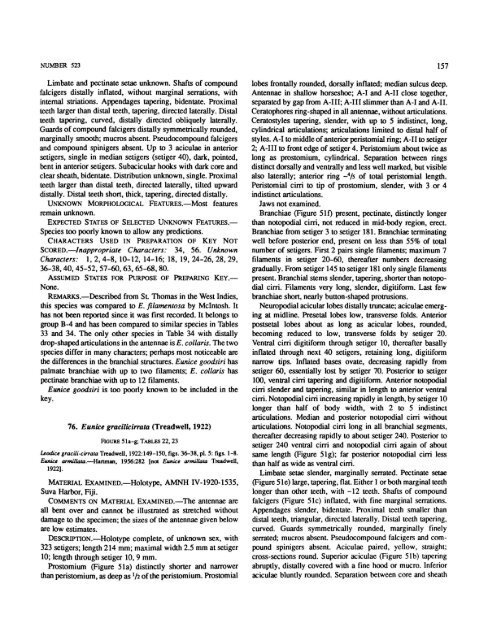A Review of the Genus Eunice - Smithsonian Institution Libraries
A Review of the Genus Eunice - Smithsonian Institution Libraries
A Review of the Genus Eunice - Smithsonian Institution Libraries
You also want an ePaper? Increase the reach of your titles
YUMPU automatically turns print PDFs into web optimized ePapers that Google loves.
NUMBER 523 157<br />
Limbate and pectinate setae unknown. Shafts <strong>of</strong> compound<br />
falcigcrs distally inflated, without marginal serrations, with<br />
internal striations. Appendages tapering, bidentate. Proximal<br />
teeth larger than distal teeth, tapering, directed laterally. Distal<br />
teeth tapering, curved, distally directed obliquely laterally.<br />
Guards <strong>of</strong> compound falcigers distally symmetrically rounded,<br />
marginally smooth; mucros absent. Pseudocompound falcigers<br />
and compound spinigers absent. Up to 3 aciculae in anterior<br />
setigers, single in median setigers (setiger 40), dark, pointed,<br />
bent in anterior setigers. Subacicular hooks with dark core and<br />
clear sheath, bidentate. Distribution unknown, single. Proximal<br />
teeth larger than distal teeth, directed laterally, tilted upward<br />
distally. Distal teeth short, thick, tapering, directed distally.<br />
UNKNOWN MORPHOLOGICAL FEATURES.—Most features<br />
remain unknown.<br />
EXPECTED STATES OF SELECTED UNKNOWN FEATURES.—<br />
Species too poorly known to allow any predictions.<br />
CHARACTERS USED IN PREPARATION OF KEY NOT<br />
SCORED.—Inappropriate Characters: 34, 56. Unknown<br />
Characters: 1, 2, 4-8, 10-12, 14-16; 18, 19, 24-26, 28, 29,<br />
36-38,40,45-52, 57-60,63, 65-68,80.<br />
ASSUMED STATES FOR PURPOSE OF PREPARING KEY.—<br />
None.<br />
REMARKS.—Described from St. Thomas in <strong>the</strong> West Indies,<br />
this species was compared to E. filamentosa by Mclntosh. It<br />
has not been reported since it was first recorded. It belongs to<br />
group B-4 and has been compared to similar species in Tables<br />
33 and 34. The only o<strong>the</strong>r species in Table 34 with distally<br />
drop-shaped articulations in <strong>the</strong> antennae is E. collaris. The two<br />
species differ in many characters; perhaps most noticeable are<br />
<strong>the</strong> differences in <strong>the</strong> branchial structures. <strong>Eunice</strong> goodsiri has<br />
palmate branchiae with up to two filaments; E. collaris has<br />
pectinate branchiae with up to 12 filaments.<br />
<strong>Eunice</strong> goodsiri is too poorly known to be included in <strong>the</strong><br />
key.<br />
76. <strong>Eunice</strong> gracilicirrata (Treadwell, 1922)<br />
FIGURE 51a-g; TABLES 22,23<br />
Ltodice gracilicirrata Treadwell, 1922:149-150, figs. 36-38, pi. 5: figs. 1-8.<br />
<strong>Eunice</strong> arndllata.—Hartman, 1956:282 [not <strong>Eunice</strong> armillata Treadwell,<br />
1922].<br />
MATERIAL EXAMINED.—Holotype, AMNH IV-1920-1535,<br />
Suva Harbor, Fiji.<br />
COMMENTS ON MATERIAL EXAMINED.—The antennae are<br />
all bent over and cannot be illustrated as stretched without<br />
damage to <strong>the</strong> specimen; <strong>the</strong> sizes <strong>of</strong> <strong>the</strong> antennae given below<br />
are low estimates.<br />
DESCRIPTION.—Holotype complete, <strong>of</strong> unknown sex, with<br />
323 setigers; length 214 mm; maximal width 2.5 mm at setiger<br />
10; length through setiger 10,9 mm.<br />
Prostomium (Figure 51a) distinctly shorter and narrower<br />
than peristomium, as deep as x /i <strong>of</strong> <strong>the</strong> peristomium. Prostomial<br />
lobes firontally rounded, dorsally inflated; median sulcus deep.<br />
Antennae in shallow horseshoe; A-I and A-II close toge<strong>the</strong>r,<br />
separated by gap from A-I II; A-I 11 slimmer than A-I and A-II.<br />
Ceratophores ring-shaped in all antennae, without articulations.<br />
Ceratostyles tapering, slender, with up to 5 indistinct, long,<br />
cylindrical articulations; articulations limited to distal half <strong>of</strong><br />
styles. A-I to middle <strong>of</strong> anterior peristomial ring; A-II to setiger<br />
2; A-I 11 to front edge <strong>of</strong> setiger 4. Peristomium about twice as<br />
long as prostomium, cylindrical. Separation between rings<br />
distinct dorsally and ventrally and less well marked, but visible<br />
also laterally; anterior ring ~ 4 /s <strong>of</strong> total peristomial length.<br />
Peristomial cirri to tip <strong>of</strong> prostomium, slender, with 3 or 4<br />
indistinct articulations.<br />
Jaws not examined.<br />
Branchiae (Figure 510 present, pectinate, distinctly longer<br />
than notopodial cirri, not reduced in mid-body region, erect.<br />
Branchiae from setiger 3 to setiger 181. Branchiae terminating<br />
well before posterior end, present on less than 55% <strong>of</strong> total<br />
number <strong>of</strong> setigers. First 2 pairs single filaments; maximum 7<br />
filaments in setiger 20-60, <strong>the</strong>reafter numbers decreasing<br />
gradually. From setiger 145 to setiger 181 only single filaments<br />
present. Branchial stems slender, tapering, shorter than notopodial<br />
cirri. Filaments very long, slender, digitiform. Last few<br />
branchiae short, nearly button-shaped protrusions.<br />
Neuropodial acicular lobes distally truncate; aciculae emerging<br />
at midline. Presetal lobes low, transverse folds. Anterior<br />
postsetal lobes about as long as acicular lobes, rounded,<br />
becoming reduced to low, transverse folds by setiger 20.<br />
Ventral cirri digitiform through setiger 10, <strong>the</strong>reafter basally<br />
inflated through next 40 setigers, retaining long, digitiform<br />
narrow tips. Inflated bases ovate, decreasing rapidly from<br />
setiger 60, essentially lost by setiger 70. Posterior to setiger<br />
100, ventral cirri tapering and digitiform. Anterior notopodial<br />
cirri slender and tapering, similar in length to anterior ventral<br />
cirri. Notopodial cirri increasing rapidly in length, by setiger 10<br />
longer than half <strong>of</strong> body width, with 2 to 5 indistinct<br />
articulations. Median and posterior notopodial cirri without<br />
articulations. Notopodial cirri long in all branchial segments,<br />
<strong>the</strong>reafter decreasing rapidly to about setiger 240. Posterior to<br />
setiger 240 ventral cirri and notopodial cirri again <strong>of</strong> about<br />
same length (Figure 51g); far posterior notopodial cirri less<br />
than half as wide as ventral cirri.<br />
Limbate setae slender, marginally serrated. Pectinate setae<br />
(Figure 5 le) large, tapering, flat. Ei<strong>the</strong>r 1 or both marginal teeth<br />
longer than o<strong>the</strong>r teeth, with -12 teeth. Shafts <strong>of</strong> compound<br />
falcigers (Figure 51c) inflated, with fine marginal serrations.<br />
Appendages slender, bidentate. Proximal teeth smaller than<br />
distal teeth, triangular, directed laterally. Distal teeth tapering,<br />
curved. Guards symmetrically rounded, marginally finely<br />
serrated; mucros absent. Pseudocompound falcigers and compound<br />
spinigers absent. Aciculae paired, yellow, straight;<br />
cross-sections round. Superior aciculae (Figure 51b) tapering<br />
abruptly, distally covered with a fine hood or mucro. Inferior<br />
aciculae bluntly rounded. Separation between core and sheath
















